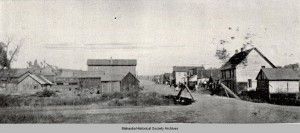Lost Mahaska Community Muchakinock Topic Of Area Historian

Iowa Coal Mine Historian Doug Wilson gave a lecture on the history of Muchakinock this past week at the Oskaloosa Public Library. (photo by Ginger Allsup)
Oskaloosa, Iowa – The impact Mahaska County had on the State of Iowa and its railroad system was the subject of local historian Doug Wilson. Wilson focused on the long lost town of Muchakinock this past week at a special presentation at the Oskaloosa Public Library.
“As the number of rail miles increased, the number of mines increased,” said Wilson. Railroads often developed their own mines, and the mine at Muchakinock was no exception.
Wilson said that the Iowa coal industry prospered from the mid-1880’s until the mid-1920’s. In approximately 1895, nearly 350 coal mines were in operation with approximately 6,900 miners. By 1925, there was well over 350 mines and over 11,000 miners employed.
Muchakinock, once known as Coal Valley, is long gone, with only a cometary marking the fact that this town once existed. Many of us drive past the once bustling community, located on the east side of 63 just south of Oskaloosa, near the current landfill, on a regular basis.
During the 1860’s, Muchakinock was nothing more than a small trading post between Oskaloosa and Eddyville, until some eastern capitalists purchased the mines. One of these persons was H.W. McNeil, who was General Superintendent of the Consolidation Coal Company. The company shipped upwards of 150 tons of coal daily from Muchakinock.
The McNeil stone mansion remains as a landmark of the Oskaloosa community.
In 1879, the McNeil’s changed how miners were compensated for their work, and the miners went on strike. McNeil sent representatives to Virginia to recruit Black mine laborers.
By 1881, the McNeil’s sold off the entire Consolidated Coal Company to the Northwestern Railroad for about a half-million dollars. Northwestern Railroad then put John Buxton in charge of the operation and he became the major supplier of locomotive coal for the company.
In 1885, the population of Muchakinock was put at 1,200, with public schools, churches and 4 daily stages to Oskaloosa, which cost 25 cents. Miners also utilized local businesses such as the drug store, general store, meat market, saloon and black smith. An opera house helped to keep local residents entertained, with 2 company physicians helping to keep the community well.
By 1895, the population had grown to nearly 3,000. Numerous new businesses continued to spring up in town, including restaurants, two saloons, a telephone office, a town hall, four grade schools, the African Methodist Episcopal Church and the Union Valley Baptist Church.
“There you have what there was in the late 1800’s, in that valley down there. It just boggles my mind when I drive down there and I look left, and I look right, and think of all that was there. There’s nothing there anymore,” said Wilson.
Muchakinock, after the influx of Black labor from Virginia, became a community where members enjoyed a area much more favorable for blacks, more so than was the case in a majority of the county. Muchakinock became the states largest unincorporated coal mining community. The black workers lived on the west side of what is now Highway 63, stretching to the town of Given. The immigrants from Sweden lived to the north of Muchakinock, in what was called Swedtown.

The community of Muchakinock, located 5 miles south of Oskaloosa. The road going from left to right is now Highway 63. (photo from Mahaska Historical Society Archives)
Many young boys, as young as 6, were used in the coal mining industry, many times to help their fathers and their families earn a living.
Families had 2 options in Muchakinock for housing. They could rent a home from Consolidated or they could rent the ground and build their own home on it.
“Coal mining was a transit society,” said Wilson, who displayed images of the concrete slabs that homes were built upon so they could be easily moved later on. Muchakinock and Buxton were somewhat an anomaly in regards to mining towns, in “how the people stayed in one place for so long.”
By 1897, the Consolidated Coal Company was still operating 4 mines in the Muchakinock area. These were the 6,7,8 and Number 9 mines, and they employed over 600 men.
The Number 2 mine of the Consolidated Coal Company is right where the current Mahaska County Landfill is now located. It was later strip mined, removing the remaining coal from that area. The number 7 mine was located approximately 1/2 a mile straight east of the current Van Gorp area south of Oskaloosa.
Doug Wilson is a locator of abandoned underground coal mines in Iowa. He’s also a collector of old mine photographs, mining camps and families. Wilson provides lectures and demonstrations on Iowa Coal Mine History.










